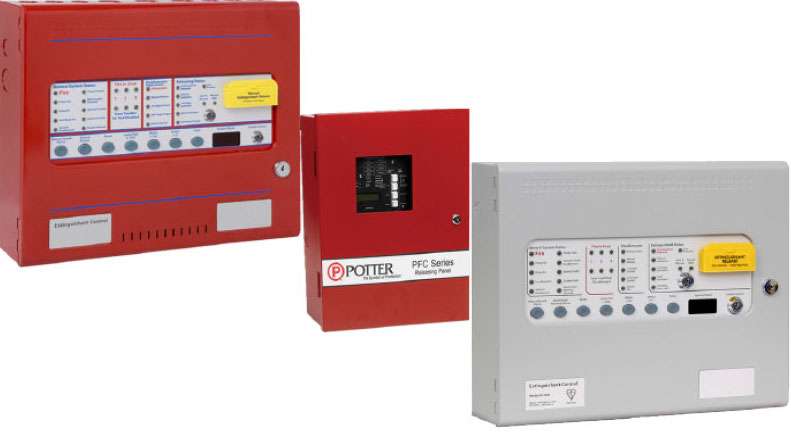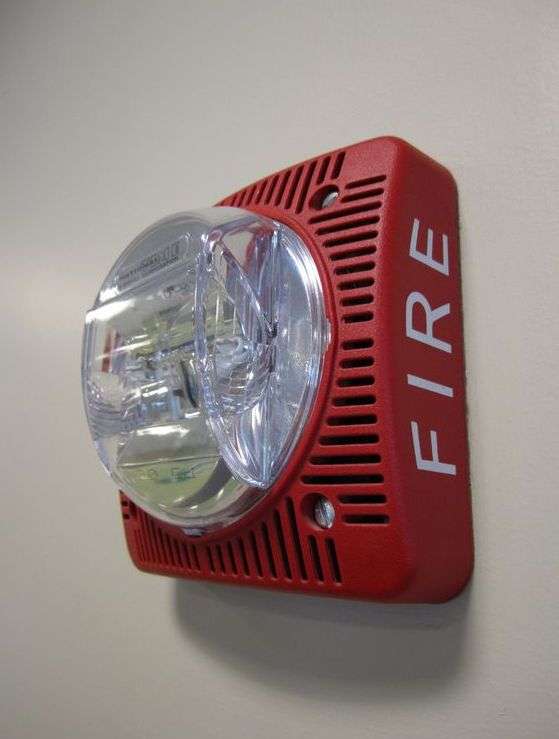Safeguarding Your Property and Lives
Fire poses a major threat to buildings, making installation of an effective fire suppression system important. In this article, we will explore these systems’ types, components, benefits, and regulations, while guiding you through the intricacies of fire safety.

part of fire Suppression systems
Detectors and Alarms
Nozzles
Control Panels
Manual Release
Abort Switch
Sounder With Flasher
Solenoid
Types of Fire Suppression Systems
Dry Fire Suppression Systems
Dry systems are explained, highlighting their operation without water until activated.
Control Panel in Fire Suppression System

1. System Integration:
Centralized Control: The control room is a centralized center that connects and controls all the Components of the fire Suppression system.
Integration with detectors: It receives signals from detectors when a potential fire is detected, and initiates an appropriate response. The Extinguisher will not be released upon Zone 1 activation. The Extinguisher will be released upon Zone 2 activation
2. Communication with alarm:
Alarm integration: The control panel communicates with the alarm, triggering audible and visual alerts to warn occupants of a fire emergency.
Evacuation Signal: It can also trigger an evacuation signal to safely guide occupants out of the building.
3. Monitoring and Diagnosis:
Continuous monitoring: The control panel continuously monitors the status of detectors, alarms, and other system components.
Diagnostics: It performs diagnostics to detect any faults or malfunctions, providing early warning for system maintenance.
4. User Interface:
User-friendly interface: The Control Panel has a user-friendly interface for system configuration, testing, and maintenance.
Status indicators: Visual indicators display the current status of the system, indicating normal operation or warning conditions.
5. Emergency Response Coordination:
Communication with building systems: In advanced systems, the control panel can communicate with other building systems (such as HVAC or access control) to optimize emergency response.
Emergency services integration: Some control panels can integrate with emergency services, allowing them to be automatically notified in the event of a fire.
6. Override and Manual Control:
Manual Activation: The control panel often allows manual activation of the suppression system in an emergency.
Override Function: It can provide override functions to allow authorized personnel to manually control specific aspects of the system.
Installation of Fire Suppression System Detectors and Alarms

Design and Planning:
System Design: Before installation, a comprehensive design is developed keeping in mind the layout, size, and purpose of the building.
Detector placement: Strategically placing detectors in fire risk areas, such as electrical rooms, and storage areas.
2. Selection of detectors:
Types of detectors: Selecting the appropriate type of detectors based on the nature of potential fire hazards (e.g., heat detectors, smoke detectors, or a combination of the two).
Technology: Selecting detectors with advanced sensing technologies for quick and accurate detection of fire.
3. Wiring and Power Supply:
Electrical wiring: Running electrical wiring to connect detectors and alarms to a central control room.
Power supply: Ensuring a reliable power supply for continued operation, including a backup power source in case of frequent outages.
4. Installation of smoke detectors:
Ceiling mounting: Installing smoke detectors on the ceiling to ensure quick detection as soon as smoke appears.
Avoiding obstructions: Place detectors away from obstructions that may hinder their ability to sense smoke.
Installation of Nozzles in Fire Extinguisher Systems
Detailed planning: Before installation, a comprehensive design is developed taking into account the type of fire hazards present and appropriate fire suppression agents.
Strategic Placement: The nozzles are strategically placed based on the specific characteristics of the space, ensuring complete coverage.
Selection of nozzle:
Type Considerations: Selecting the appropriate type of nozzle based on the fire extinguishing agent being used (for example, 360/180) will have 360 inserted in the middle and 180 on the sides and even top of the sill.
Manual Release Mechanism

1. User Initiated Activation: The manual release feature allows users or authorized personnel to manually activate the FM200 system.
Emergency Response: It is generally used in emergencies where immediate action is required to suppress the fire.
2. Activation Process:
Pull station or manual button: Manual release is often facilitated through pull stations or manual release buttons located in strategic areas.
Start Signal: Activating the manual release sends a signal to the control panel, initiating the release of the FM200.
3. Use Cases:
Emergencies: Manual release is used when fire is confirmed, and immediate suppression is necessary.
Typical applications: This is common in environments containing critical equipment, data centers, archives, and other locations where water-based suppression is not suitable.
4. Benefits:
Quick Response: Manual release ensures quick response in case of a fire emergency, reducing potential damage.
Abort Switch

Emergency Interrupt: The primary purpose of the abort switch is to provide authorized personnel with a means to interrupt or abort the release of the FM200 in an emergency.
2. Location:
Strategic Placement: Abort switches are usually strategically located in accessible areas within the protected space.
Near emergency exits: Often placed near emergency exits or in areas where employees can quickly access switches.1. Objective:
Emergency Interrupt: The primary purpose of the abort switch is to provide authorized personnel with a means to interrupt or abort the release of the FM200 in emergencies.
2. Location:
Strategic Placement: Abort switches are usually strategically located in accessible areas within the protected space.
Near emergency exits: Often placed near emergency exits or in areas where employees can quickly access switches.
3. Activation Mechanism
Manual Operation: The switch is operated manually, requiring deliberate action from authorized personnel.
Push or Toggle Design: Abort switches can be designed as push-button or toggle switches depending on the system specifications.
4. Use Cases:
False Alarm: In case of a false alarm or when it is determined that suppression is not necessary, the abort switch can be activated by pushing the abort switch for 10 seconds before giving it another 30 seconds.
Evacuation Scenarios: During evacuation scenarios, the switch allows interruption of FM200 release to ensure occupant safety.
5. Integration with Control Panel:
Connected System: The abort switch is integrated into the overall fire extinguishing system, connected to the control panel.
Communication Protocol: When activated, the switch sends a signal to the control panel to stop the release process.
Activation of Fire Suppression System sounder with flasher

Emergency Notification: The sounder with flasher serves as an emergency notification device to alert building occupants of a fire or activation of the fire suppression system.
Enhanced Visibility: The combination of sound and flashing light ensures that the alert is noticeable even in noisy or visually impaired environments.
2. Location:
Strategic placement: Sounders with flashers are placed inside and outside the room and strategically placed at different locations in a building or protected area.
Solenoid

The solenoid is responsible for precisely controlling the flow of FM200 from the storage container to the distribution pipe.
On/Off Functionality: It can open and close rapidly, allowing instant and precise control of discharge.
2. Activation Mechanism:
Integral Part of System Activation: The solenoid is part of the overall activation mechanism of the FM200 fire suppression system.
Connected to detection system: Receives signal from fire detection system to release FM200 in case of fire.
3. Safety related matters:
Rapid Response: The solenoid enables quick response to fire emergencies by facilitating the quick release of FM200 gas.
Fixed Fire Suppression System Service

inspection:
* Regular visual inspection of the entire fire extinguishing system.
* Checking major components like detectors, alarms, sprinklers, nozzles, and control panels.
Testing:
* Functional testing of individual system components to ensure that they work as intended.
* Simulated activation testing to verify system readiness in real-world scenarios.
maintenance:
Cleaning and cleaning nozzles and sprinklers to prevent blockages.
Lubrication and adjustment of mechanical components.
Replacement of any damaged parts.
4. Record Keeping:
* Complete documentation of all inspections, tests, and maintenance activities.
* Keeping a detailed log of any replacements or repairs made.
5. Compliance Check:
* Verification of compliance of the system with relevant fire safety regulations.
*manufacturer recommendations and industry standards.
Conclusion
fire suppression systems are critical components in high-risk environments such as commercial kitchens and industrial facilities. These systems require specialized maintenance and repair services to ensure they are working properly and can respond quickly in the event
FAQs
A. What is the primary purpose of a fire suppression system?
Briefly explain the main functions of fire suppression systems.
B. How are dry and wet fire suppression systems different?
Highlighting the differences between dry and wet systems.
C. Are fire extinguishing systems mandatory in all buildings?
To clarify rules related to the installation of fire suppression systems.
D. Can I install the fire suppression system myself?
Addressing the importance of business setup.
Also, visit my site fabwayhub.com


